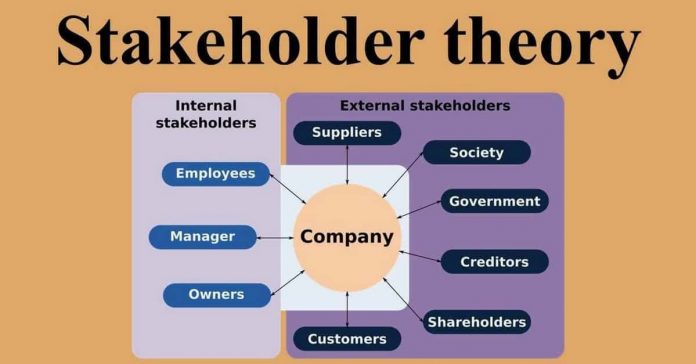This article is written by Miss Srestha Nandy from IMS Unison University, Dehradun. This is an exhaustive article which deals with the analysis of the stakeholder theory.
Table of Contents
Introduction
The concept of stakeholder is very broad and the interesting aspect of it is that even the competitors are the stakeholders of a concerned company. This is because whosoever has an interest in the organization’s working is to be a stakeholder of that company. In the case of competitors, one company always retains the knowledge of the upcoming innovations of its competitors in the same market.
Our market is mainly focused on maximizing profitability, the efforts are more towards the management of the shareholders, and towards the allocations of knowledge regarding the updates in the technology, profits, losses, share prices, etc. Besides these, one of the essential perspectives, the management of the stakeholders often gets ignored. Internal stakeholders are the primary labourers in the company, without them, the operations won’t get completed, and the product will not reach the market in an appropriate finished manner.
Therefore the theory of stakeholders holds an effective position in the management of the company. The founder of this theory is R. Edward Freeman, an expert in the field of stakeholder management, leadership, business ethics, conscious capitalism, etc.
The concept of stakeholder
Precisely there are two kinds of stakeholders, one who has a direct relationship with the organization, while the other is the external stakeholder, those who get affected by the actions and the outcomes of the business though they do not work with the company. Suppliers, creditors, or public groups are considered external stakeholders.
In simple language, a firm invests capital in a start-up in return for a certain percentage of equity, where the firm becomes the internal stakeholder. In this, the firm has a vested interest as the return on the investment is attached to the success of the startup. External stakeholders are a bit different from the previous ones. Government acts as an external stakeholder, as in case of changes in the policies or provisions, the companies’ business is affected.
Even considering the pandemic situation, due to the fall of GDP, the stock market faced several consequences. Unemployment increased rapidly, where major stocks like FTSE dropped by 14.3% in the year 2020, after 2008.
The importance of stakeholders lies in managing the relationship with the internal and external stakeholders with the company, as the operation of the organization is on the capability of the internal stakeholders, while the business depends on the market, where the customers’ preferences, distribution of the supplier, government policies, etc exists. But there lies another aspect where a conflict exists in the relation of the stockholders and the corporations. Corporations aim to maximize the profit, but also keep tight control over the labour costs. This, on one hand, pleases the shareholders whereas disappoints the stakeholders or to be specific the employees.
Mother nature is a key stakeholder
For the existence of a company, the basic requirement of an organization is an environment and the supporting essentials of the environment. For a long time companies did not consider the environment as an essential element, but when they encountered the crisis and became unable to get a solution it was visible where the deficiency lies.
The environment provides us with four different services:
- Provisioning service – This included natural resources, like water, minerals, food, timber, etc.
- Regulating service – It consists of climate, flood, water quality,
- Supportive service – Signifies the soil formation, nutrient cycle, or the photosynthesis
- Cultural service – It involves the recreation, aesthetic, or the spiritual services
All these factors are highly essential, just imagine once if any one of them starts lacking, the whole ecosystem would start to get imbalanced.
Relation between stakeholder and shareholder
A shareholder is also a stakeholder but the stakeholder doesn’t need to be a shareholder. The shareholder is the one who holds the company’s shares, whereas stakeholders are those people who get affected by the decisions taken by the organization, and these people also include shareholders. Shareholders are only concerned about the financial interest and the profitability of the organization, do possess a right to vote, and to affect the management of a company, but direct stakeholders, specifically the employees, are more responsible for the performance of the organization. Shareholders are also known as the owners of the company whereas the stakeholders are to be known as interested parties. As shareholders hold shares of various companies, so particularly they do not have a long-term need for the company, but the stakeholders are bound to the company for the long term.
Stakeholder Theory
“The 21st Century is one of “managing for stakeholders.” The task of the executives is to create as much value as possible for stakeholders without resorting to tradeoffs. Great companies endure because they manage to get stakeholder interests aligned in the same direction.”
-R. Edward Freeman
Stakeholder theory signifies creating value for the stakeholders as in reality more importance is given to the shareholders. The theory states that a business will be successful if there is value and respect for the stakeholders, specifically the ones who are involved in the operation of the organization. The interests of these individuals should go together in the same direction.
Freeman says “Even some older companies like Unilever are re-inventing themselves to use stakeholder theory with very strong results.”
Professor McDonald says his view is simple. “If you value life in the future, you should preserve the environment by addressing pollution, using sustainable extraction from the biosphere, etc…Presumably, you act in a way that you hope will express your values, and produce an outcome that makes you happy.”
The above lines indicated that when a product is manufactured, and sold to consumers, the consumers should pay the real price of the product. Numerous underpaid employees work in tough working conditions, and these plants even cause pollution to the environment. So it is the responsibility of the directors and the executives to take care of these issues and to bring the dilemma to the concern of international law. The market should be reconstructed and transparency should be maintained, the real cost should reach the consumers and also the issues which will lead to increase the interest of the consumer regarding the production cost and would get clarified regarding the rise and fall in costs.
Principles of the theory
Freeman framed six different principles for stakeholder management.
- Principle of entry and exit – The policies regarding hiring and firing should be framed in simple language so that all the individuals having access to those get a clear understanding of context. The arrangement of the rules should be available to the one who needs it. This helps the individual to create a mindset for how to perform in case one chooses to engage with the organization.
- Principle of governance – This states that the existing rules and the policies governing the relationships between the organization and the stakeholders are amendable with unanimous consent.
- Principle of externalities – In simple language, anyone who gets affected by the business of a company becomes a stakeholder to the organization. The most prominent example of this is the environment because of pollution caused by the nature of the factory.
- Principle of contracting costs – It states that the parties must bear to that extent in case of profit or loss up to which one is involved. This is not always monetary so it becomes difficult to measure. The purpose of the principle is based on the notion of fairness.
- Agency principle – This signifies a direct challenge to the corporation, where the managers and the directors act as agents between the corporation and the stakeholders so they hold the responsibility towards both shareholders and stakeholders.
- Principle of limited immortality – The phrase ‘limited immortality’ signifies that an organization can’t become immortal but there are possibilities for surviving for the maximum period. If the existence is for a limited period then it can be beneficial for the competitors but not to the other stakeholders, also this violates the theory of stakeholders. Thus the firm must remain in existence for a long time with successions in the positions.
Benefits of stakeholder theory
The theory consists of three elements, the first one observes the corporation behaviour, the second is a framework for monitoring the relationship between stakeholder management and companies’ success. The third is normative validity, which signifies the purpose of the company. Freeman also believes that the effective implication of this theory would result in good public relations.
From a realistic point of view, there must exist a definite alignment for stakeholders. In the execution of the theory, the main focus should be on the shareholders, employees, and the customers, as reaching towards the goals, the contribution of the employees are the majority, which would result in the more efficient and effective leads to the production.
This theory also signifies the philosophy of ethical and social level in the working environment. One of the aspects of this theory creates an environment of like-minded people, which promotes social wealth for everyone and allows working with those people who believe in making a difference and contributing to a healthy competitive ecosystem. This also increases mental health satisfaction in the work environment providing objectives to the directors.
Directors are considered as the mediators, so they need to disclose all the details to the stakeholders, as having a powerful position in the organization, directors should consider the comfortable working environment, but deny those conditions which would result in compromising the benefits of the stakeholders, even if the circumstance consists of the interest of the shareholders.
Stakeholders theory is not perfect
In any committee of schools or institutions often consists of the students, actively participating in the even decision making along with the other members, but in the case of corporations, the board generally does not consist of the members of the organization itself. For example, the Board of Directors of Facebook are from different fields. Here these aspects violate the theory. The organization works with an intention and motive so is it not questionable to have outsiders on the top management of a company. If this is the scenario, then how can the internal environment get in touch with the hierarchy? This leads to increasing the gaps in the levels of the organization.
These critics support in case of favouring the shareholders more than the stakeholders. Though the stakeholder’s theory is one of the powerful theories, at the time of execution, the theoretical aspects are not followed particularly. The basics of an organization are the owners, employees, and customers. Now, how can these three be levelled? Owners who provide the capital are very important, but without the cooperation of the employees, there will be zero output. So consequently the employees are needed. Now considering the customers, without them how can the organization generate the revenue, or to whom the services will be provided. So these three people are equally important, so none of them can be placed in a higher position. Now if a conflict arises, how will it get adjudicated? The theory does not provide any preferences among the stakeholders itself, so in case of such a situation, it would be difficult to reach an outcome through the philosophy of this theory. Being a powerful theory in the books or the research, it gets ignored in the real world, where the market runs after maximizing profits.
References
- https://www.darden.virginia.edu/faculty-research/directory/r-edward-freeman
- https://www.usatoday.com/story/tech/2021/05/05/facebook-oversight-board-members-mark-zuckerberg/4954484001/
LawSikho has created a telegram group for exchanging legal knowledge, referrals, and various opportunities. You can click on this link and join:
 Serato DJ Crack 2025Serato DJ PRO Crack
Serato DJ Crack 2025Serato DJ PRO Crack










 Allow notifications
Allow notifications



